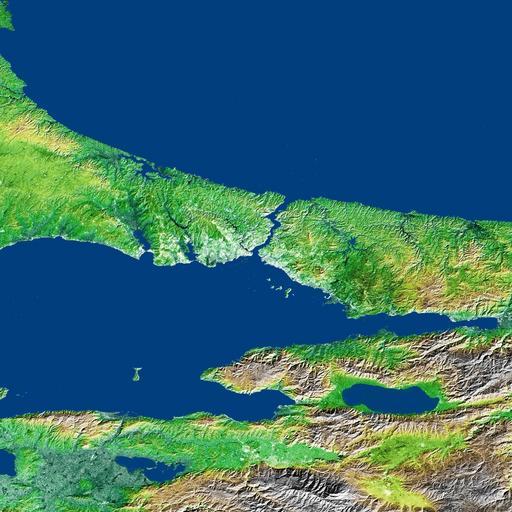MAKE A MEME
View Large Image

| View Original: | Shaded_Relief_and_Radar_Image_with_Color_as_Height,_Bosporus_Strait_and_Istanbul,_Turkey_DVIDS712179.jpg (1536x1536) | |||
| Download: | Original | Medium | Small | Thumb |
| Courtesy of: | commons.wikimedia.org | More Like This | ||
| Keywords: Shaded Relief and Radar Image with Color as Height, Bosporus Strait and Istanbul, Turkey DVIDS712179.jpg en The Bosporus also spelled Bosphorus is a strait that connects the Black Sea with the Sea of Marmara in the center of this view of northwest Turkey taken during the Shuttle Radar Topography Mission The water of the Black Sea at the top of the image and Sea of Marmara below the center are colored blue in this image along with several large lakes The largest lake to the lower right of the Sea of Marmara is Iznik Lake The Bosporus Turkish Bogazici Strait is considered to be the boundary between Europe and Asia and the large city of Istanbul Turkey is located on both sides of the southern end of the strait visible as a brighter light green to white area on the image due to its stronger reflection of radar Istanbul is the modern name for a city with along history previously called Constantinople and Byzantium It was rebuilt as the capital of the Roman Empire in 330 A D by Constantine on the site of an earlier Greek city and it was later the capital of the Byzantine and Ottoman empires until 1922 The Gulf of Izmit is the narrow gulf extending to the east right from the Sea of Marmara The city of Izmit at the end of the gulf was heavily damaged by a large magnitude 7 4 earthquake on August 17 1999 often called the Izmit earthquake also known as the Kocaeli Turkey earthquake that killed at least 17 000 people A previous earthquake under the Gulf of Izmit in 1754 killed at least 2 000people The Izmit earthquake ruptured a long section of the North Anatolian Fault system from off the right side of this image continuing under the Gulf of Izmit Another strand of the North Anatolian Fault system is visible as a sharp linear feature in the topography south of Iznik Lake Bathymetric surveys show that the north Anatolian Fault system extends beneath and has formed the Sea of Marmara in addition to the Gulf of Izmit and Iznik Lake Scientists are studying the North Anatolian Fault system to determine the risk of a large earthquake on the faults close to Istanbul that could kill many more than the 1999 event Three visualization methods were combined to produce this image shading and color coding of topographic height and radar image intensity The shade image was derived by computing topographic slope in the northwest-southeast direction Northwest-facing slopes appear dark and southeast-facing slopes appear bright Color coding is directly related to topographic height with green at the lower elevations rising through yellow and brown to white at the highest elevations The shade image was combined with the radar intensity image to add detail especially in the flat areas Elevation data used in this image was acquired by the Shuttle Radar Topography Mission SRTM aboard the Space Shuttle Endeavour launched on Feb 11 2000 SRTM used the same radar instrument that comprised the Spaceborne Imaging Radar-C/X-Band Synthetic Aperture Radar SIR-C/X-SAR that flew twice on the Space Shuttle Endeavour in 1994 SRTM was designed to collect 3-D measurements of the Earth's surface To collect the 3-D data engineers added a 60-meter approximately 200-foot mast installed additional C-band and X-band antennas and improved tracking and navigation devices The mission is a cooperative project between NASA the National Imagery and Mapping Agency NIMA of the U S Department of Defense and the German and Italian space agencies It is managed by NASA's Jet Propulsion Laboratory Pasadena Calif for NASA's Earth Science Enterprise Washington D C Size 2x2 degrees 168 by 222 kilometers; 104 by 138 miles Location 40-42 degrees North latitude 28-30 degrees East longitude Orientation North toward the top Image Data shaded and colored SRTM elevation model with SRTM radar intensity added Original Data Resolution SRTM 1 arcsecond about 30 meters or 98 feet Date Acquired February 2000 SRTM NASA Identifier PIA03349 2009-10-14 Glenn Research Center https //www dvidshub net/image/712179 712179 2012-10-10 17 11 WASHINGTON DC US PD-USGov Images from DoD uploaded by Fæ Bosphorus | ||||